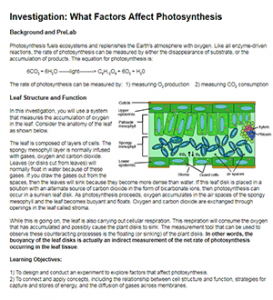
This lab, intended for AP Biology students investigates photosynthesis. Students use a straw to cut small discs from spinach. Then, they use a syringe to remove the air from the air spaces in the leaves. When leaf discs are places in a sodium bicarbonate solution, they will sink to the bottom.
Next, student expose the sunken disks to a bright light. As photosynthesis takes place, oxygen is released and is trapped under the leaf and causes it to float.
The speed and number of floating disk becomes a measure of the rate of photosynthesis. Once students are familiar with this technique, they design an experiment to measure how other factors can affect photosynthesis.
Depending on your lab stock, instructors can make available a variety of variables to test, such as: light intensity, color of light, temperature, size of disks. The lab contains introductory information and prelab questions, and has a link to a video that demonstrates the lab technique.
Students complete a CER (claim, evidence, reasoning) for observations made showing the relationship between sodium bicarbonate and rate of photosynthesis.
Lab report guidelines are included if you wanted to assign a lab report, but it is not necessary for the activity.
Students can also do a virtual version of this lab, where they can use an app to manipulate light intensity and color. Plant growth changes with those variables.
Grade Level: 11-12 | Time Required: ~90 minutes
HS-LS2-5 Develop a model to illustrate the role of photosynthesis and cellular respiration in the cycling of carbon among the biosphere, atmosphere, hydrosphere, and geosphere.

